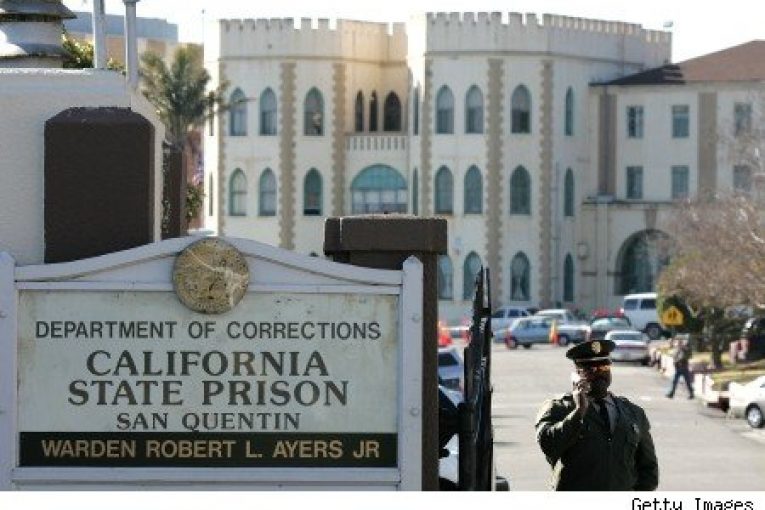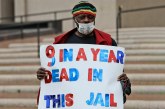
(Dashboard updates daily M-F)
By Julietta Bisharyan and Mella Bettag
Incarcerated Narratives
Despite the outbreak raging through San Quentin, several journalists from the San Quentin news are determined to continue writing and get their stories out.
In his interview with Mother Jones in April, Kevin Sawyer discussed how he was reporting from the prison.
Sawyer is the associate editor on the San Quentin News, and has continued to write and conduct interviews while in lockdown.
“One way I do interviews on lockdown is to write notes with questions. Inmates are sometimes more willing to write about what’s happening to them instead of filing a grievance. Because of my tenure and reputation with San Quentin News, they know me and trust that I will not exploit them or place them in a negative light.”
He then gets someone who is out of their cell to deliver the note to the person he’s interviewing. “If it’s in a sealed envelope I have to inform the “runner” of the “kite” (prison slang for a letter or note) that it’s not “hot.” That means there is no incriminating or illegal information in the note, that if intercepted by a correctional officer during a random search it will not subject the runner to disciplinary treatment.”
Sawyer had prepared for a lockdown before it was implemented, gathering writing materials like typewriter ribbons, post-it notes, and carbon paper, along with many legal reference guides, dictionaries and more.
“In my cell, I keep names and addresses of outside media (including yours, obviously) that I acquired over the years. In a single word, prepared is what I am.”
Juan Haines is also a journalist with the San Quentin News, and has been talking with Solitary Watch since mid-April about what is happening in San Quentin. Haines ended up contracting the disease, and on July 2nd, he discussed his experience with Emily Nonko.
After testing positive, Haines was put into the Badger Section, a block of cells that was used as solitary confinement. This has been a concern with CDCR’s handling of the pandemic- by making quarantine the same as punishment, inmates are less likely to report symptoms or accept testing for fear of solitary.
“I really wish that the administration would treat us like patients. And if we’re treated like patients who have a disease, then that’s how we would feel. But we don’t feel like that. We feel like we’re being punished because of this disease”, Haines said.
Haines also mentioned the lack of quality medical attention he received. “The medical attention they’ve given me after testing positive for COVID-19 is that they locked me into a cell, they give me cold meals (for every meal). I can’t even heat up water, if I wanted to heat up the meals that they’re giving me. There’s no mental health services at all…We have COVID-19, and all they’re doing is passing out Tylenol.”
The lack of immediate medical attention also came up. Haines discussed an incident in which someone in Badger needed immediate care, shouting “man down” to get a staff member’s attention. According to Haines, “It took them about nine minutes to respond.”
“The people who are in charge of our lives, who are supposed to be our overseers to our lives are just incompetent. Because the people who are making decisions aren’t coming to talk to us—whoever they’re talking to—they’re not representing who we are.”
After Rashid Lockhart was released in January, he felt helpless. Lockhart, who worked on a fire crew at San Quentin, has been hearing about COVID-19 from his friends who are still incarcerated.
In an interview with KCBS, Lockhart described his worries about the outbreaks. Firstly, he expressed his concern for all of those who were not being released. “There are human beings in there who are worth releasing right now, who are great members of our society, who just need the opportunity”.
He also shared his concern about the ambulance crew’s experience as well, saying their workload had shot up during the pandemic. “My guys at the firehouse we like, ‘We’re getting more calls than we can handle.’ I talked to one guy one time. It was like nine o’clock in the morning. He said, ‘We’ve had five calls already this morning. But there was a total of 11. We were only able to respond to five of them.'”
Currently, Lockhart cannot return to emergency services due to his felony record, so he is working as a re-entry coordinator at Plating Justice, a nursery that employs formerly incarcerated people in East Oakland.
“I’m going to try to help those who need help get jobs or be able to have some sense of a network or support coming out of incarceration.”
On Aug. 5, a 34-year-old male parolee was released early from Soledad State Prison due to the CDCR’s early release program. Later, he was found in medical distress by California Highway Patrol and Caltrans personnel, near an Ukiah homeless encampment before passing away from an overdose.
According to Izen Locatelli, Mendocino County’s Chief Probation Officer, the county would have provided the parolee transitional housing and required him to quarantine if he was released under Post Release Community Supervision (PRCS).
As evidenced by the late parolee’s homelessness, Locatelli believes that Governor Newsom’s rush to release prisoners to decrease COVID-19 cases “has outpaced the planning to support them.”
CDCR Confirmed COVID-19 Cases and Outcomes
As of August 14th, there are a total of 9,271 confirmed COVID-19 cases in the CDCR system, with 1,000 in the last two weeks. 12.5% of the cases are active in custody while 3.4% have been released.
There have been 53 deaths across the CDCR system thus far, with San Quentin Prison (SQ) making up 47% of total deaths.
On Tuesday, Sierra Conservation Center (SCC) in Jamestown and Valley State Prison (VSP) in Chowchilla recorded its first few cases. Only two facilities, Deuel Vocational Institution (DVI) in Trinity and Pelican Bay State Prison (PBSP) in Crescent City, have zero confirmed cases.
Despite testing the highest number of patients last week, testing at PBSP continues to decline rapidly, as only 1% of the population has been tested in the last 14 days.
At the same time, California Institution for Women (CIW) has tested the most in the last two weeks –– 62% of its population.
The number of cases at California Men’s Colony (CMC) has nearly doubled this week, from 97 active cases on August 7 to 183 active cases today. The cases at CMC account for more than 17% of the 1,184 active incarcerated cases for CDCR statewide.
“The California Men’s Colony (CMC) continues to work closely with the San Luis Obispo County Public Health Department in regards to the continuous testing of CMC’s incarcerated population,” reads a statement issued by CMC officials. “CMC is making a proactive and non-stop effort to locate and treat incarcerated persons who are infected with COVID-19. Fewer than ten inmates are hospitalized as a result of COVID-19 infection.”
Mule Creek State Prison (MCSP) in Ione released their first 10 active individuals overnight. There are currently 28 positive cases in custody while one individual has been released while active.
COVID-19 in CDCR’s San Quentin
There have been two deaths this week at San Quentin, totaling to 25 there.
One of the individuals is Sgt. Gilbert Polanco, the first prison guard to die of COVID-19.
So far, 261 workers at San Quentin have been infected with the virus, but Polanco was the first to die among the Marin County facility’s staff.
Polanco was an Army veteran and guard at the facility since 1988. He had been hospitalized with the virus since Jul. 3.
“Sgt. Gilbert Polanco is an example of the best of CDCR and his passing deeply saddens us all,” said CDCR Secretary Ralph Diaz in a statement. “His dedication to public service will not be forgotten.”
On Sunday, Pedro Arias, 58, was also pronounced deceased at an outside hospital. Although it appears that he has passed away from complications related to COVID-19, a coroner is yet to determine the exact cause of death.
On Feb. 22, 1990, Arias was sentenced to death in Sacramento County for first-degree murder and three counts of second-degree robbery while armed with a knife. He was admitted onto death row on Mar. 5, 1990.
Arias was also sentenced to 67 years to life for kidnapping for robbery with use of a handgun, kidnapping with use of a handgun, two counts of penetration with a foreign object with the use of a handgun, two counts of attempted sodomy with the use of a handgun, two counts of rape with use of a handgun, two counts of second-degree robbery and enhancements for the use of a firearm, and one count oral copulation with use of a handgun.
After a petition, asking for immediate release, was filed by over 40 incarcerated people at SQ, a judge in Marin County is beginning to consider the grievances.
In the petition, they argue that their continued incarceration during the outbreak violates the Eighth Amendment of the U.S. Constitution, which prohibits “cruel and unusual punishments.”
They are being represented by the public defender offices in Marin, San Francisco and Alameda counties, as well as the Santa Clara County Alternate Defender Office and Charles Carbone, a prisoner rights lawyer in San Francisco.
“The reality is people are continuing to die in San Quentin,” said Marin County Public Defender Jose Varela.
Last week, Judge Geoffrey Howard ordered CDCR to respond to the writs. The state attorney general’s office has since responded, saying that the petitions fail to meet several procedural requirements.
“Petitioners have not established they will suffer irreparable injury, particularly in light of the declining number of inmates affected by COVID-19 and the CDCR’s measures to prevent the spread of COVID-19,” wrote Deputy Attorney General Kathleen Walton.
Carbone, the prison rights attorney, believes that the declining number of cases is attributed to the fact that those who were going to get the virus already did.
“What we’re asking the Marin court to acknowledge is the [California Department of Corrections and Rehabilitation] is at least deliberately indifferent to the lives and well-being of the people inside [San Quentin],” said Danielle Harris, managing attorney of the San Francisco Public Defender’s Office, during a virtual news conference hosted by Oakland’s Ella Baker Center for Human Rights. “Unfortunately, we are in crisis again. The law now requires the court to step in … to prevent further carnage.”
CDCR Staff
There are currently 2,283 staff cases in the CDCR facilities. 1,231 are currently active while 1,053 have returned back to work.
Back in July, a union representing thousands of California prison employees filed a grievance against the state corrections department and its health care system, charging that officials are exposing staffers to “uncontrolled” coronavirus outbreaks inside state-run prisons by recklessly moving prisoners and failing to follow health and safety guidelines.”
The union, SEIU Local 1000, is not asking for monetary damage, just for the state to ensure that proper protocols are created and enforced.
CDCR spokeswoman Dana Simas says that the state prison system and the California Correctional Health Care Services “have implemented a number of extraordinary and unprecedented measures to protect people who live and work in our institutions.
These measures include issuing cloth masks to all staff and incarcerated people and enforcing 6 ft social distancing. A work group has also been established to monitor personal protective equipment.
The filed grievance may be submitted to a neutral arbitrator to come to an agreeable resolution for both parties.
At Folsom State Prison (FSP), an employee has died “from potential complications related to the Novel Coronavirus.” This is the 10th death reported by the state among prison workers.





When I wrote my resolution against the immigrant detention centers, backed by People Power and adopted by both the City of Davis and the Yolo County Board of Supervisors, I had a number of people tell me they were able to fully support it because I had chosen noninflammatory language. I had also weakened my initial wording significantly. The initial wording had been inflammatory, but also in my opinion accurate. The initial words I had chosen were concentration camps based on the following definition:
“…a place where large numbers of people, especially political prisoners or members of persecuted minorities, are deliberately imprisoned in a relatively small area with inadequate facilities…”
I would now like to return to the use of that term. My reasoning is that I am not using the term concentration camp to mean “death camp”. True, we are not shooting or gassing people. But what we are doing is confining large numbers of people in a relatively small area with inadequate facilities. Furthermore, we are doing so at a time of the known pandemic. The factors that promote viral spread are well known and apply to these facilities. I would further note that the conditions that favored the spread of typhus were well known at the time of WWII and that many of those confined died not from bullets or gas, but from typhus which was allowed to run rampant within the camp confines. We are indeed running concentration camps, just not “death camps” as most people construe that term.
This is not the country in which I want to live. Oh, but did I mention we are all virtual prisoners here now?
I know some Jews feel differently, but as the term is most often used in reference to the pre-and-WWII Nazi camps, I find the use of it here to be purposefully over-inflammatory, for the very reason that “we are not shooting or gassing people”. There is a BIG leap to shooting and gassing people. I fully support anyone who wishes to fight for their rights and for better conditions for detainees. However, I find the use of this term a bit offensive, and mostly inaccurate, not because of the technical definition, but because of the association from the far most common use — which I think is purposeful.
I would like this country, on both sides, to edge back towards describing things as they are, rather than the politics of hyper-charged phrases. Therefore, I would urge you to name them what they are, even if more neutral and less headline-grabbing, and call out the issues as you see them, strongly. No, I am not so offended that I won’t talk to you anymore or anything like that — that isn’t my M.O. — but I did want to let you know, publicly on “the blog” (there can be only one) since that is where you posted — how I feel.
I think a lot of Jews view the lesson of the holocaust as the failure to stop atrocities when they were containable as opposed to at the point when they were gassing millions.
Tia… I think if you fully look at the records of the ‘concentration camps’, those typhus outbreaks, %-age wise, took the same toll on both captors, and captives, particularly when adjusted for poorer starting health and lack of medical treatment of the captive was less.
But as I understand it, the incidence of infection from typhus was about the same, (%), but the outcomes differed… lots of prison guards at the concentration camps were infected, and died…
Not a good parallel…
Bill
I disagree with your analysis. It is not just the prisoners that are subject to the virus. All those who come in contact with them, anyone in custody, is susceptible to contracting the virus and spreading it in the community where it needs only the opportunity to spread freely.
Typhus did not care who was infected and neither does the novel coronavirus. Analogy holds.
I am thinking that the phrase “Never again” would mean prevention before deaths are occurring, not after they have started.
A tad “over the top”…
Covid, Tay-Sachs, CF, Sickle Cell Anemia, Pancreatic Cancer, violence, DUI’s, etc. etc. etc., would all be “never again” in that scenario…
And, to infuriate, the anti-vaxxers seem not to believe in “never again” as to smallpox, measles, polio, diptheria, etc. etc…
Methinks one should be judgmental of them, too…
Bill
With the possible exception of violence, about which I am currently undecided, all the others you named except coronavirus are not infectious. There lies the major difference. And trust me, I am highly judgemental with regard to anti-vaxxers. But they are not holding anyone in a detentions center as Alan would say, or a concentration camp, as I would say. Our federal government is paying private companies to do so.
Should headline read “eight amendment” or “eighth amendment”?
Always heard that accuracy is a fundamental of journalism/reporting… doesn’t seem true today, in Sac Bee, Emptyprize, or VG…
I really don’t appreciate this comment – the second sentence. The article was written and put together by a group of about seven interns have been doing a project to track COVID cases in Jail and Prison for the last several months. They are working their tails off to do that and made a simple typo and didn’t deserve the cheap shot.